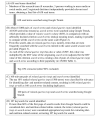Web-Based Content on Diet and Nutrition Written in Japanese: Infodemiology Study Based on Google Trends and Google Search
- PMID: 37971794
- PMCID: PMC10690527
- DOI: 10.2196/47101
Web-Based Content on Diet and Nutrition Written in Japanese: Infodemiology Study Based on Google Trends and Google Search
Abstract
Background: The increased availability of content of uncertain integrity obtained through the internet is a major concern. To date, however, there has been no comprehensive scrutiny of the fitness-for-purpose of web-based content on diet and nutrition.
Objective: This cross-sectional study aims to describe diet- and nutrition-related web-based content written in Japanese, identified via a systematic extraction strategy using Google Trends and Google Search.
Methods: We first identified keywords relevant for extracting web-based content (eg, blogs) on diet and nutrition written in Japanese using Google Trends. This process included identification of 638 seed terms, identification of approximately 1500 pairs of related queries (top) and search terms, the top 10% of which were extracted to identify 160 relevant pairs of related queries (top) and search terms, and identification of 107 keywords for search. We then extracted relevant web-based content using Google Search.
Results: The content (N=1703) examined here was extracted following a search based on 107 keywords. The most common themes included food and beverages (390/1703, 22.9%), weight management (366/1703, 21.49%), health benefits (261/1703, 15.33%), and healthy eating (235/1703, 13.8%). The main disseminators were information technology companies and mass media (474/1703, 27.83%), food manufacturers (246/1703, 14.45%), other (236/1703, 13.86%), and medical institutions (214/1703, 12.57%). Less than half of the content (790/1703, 46.39%) clearly indicated the involvement of editors or writers. More than half of the content (983/1703, 57.72%) was accompanied by one or more types of advertisement. The proportion of content with any type of citation reference was 40.05% (682/1703). The themes and disseminators of content were significantly associated with the involvement of editors or writers, accompaniment with advertisement, and citation of reference. In particular, content focusing on weight management was more likely to clearly indicate the involvement of editors or writers (212/366, 57.9%) and to be accompanied by advertisement (273/366, 74.6%), but less likely to have references cited (128/366, 35%). Content from medical institutions was less likely to have citation references (62/214, 29%).
Conclusions: This study highlights concerns regarding the authorship, conflicts of interest (advertising), and the scientific credibility of web-based diet- and nutrition-related information written in Japanese. Nutrition professionals and experts should take these findings seriously because exposure to nutritional information that lacks context or seems contradictory can lead to confusion and backlash among consumers. However, more research is needed to draw firm conclusions about the accuracy and quality of web-based diet- and nutrition-related content and whether similar results can be obtained in other major mass media or social media outlets and even other languages.
Keywords: Japanese language; diet; information; internet; nutrition; web.
©Kentaro Murakami, Nana Shinozaki, Nana Kimoto, Hiroko Onodera, Fumi Oono, Tracy A McCaffrey, M Barbara E Livingstone, Tsuyoshi Okuhara, Mai Matsumoto, Ryoko Katagiri, Erika Ota, Tsuyoshi Chiba, Yuki Nishida, Satoshi Sasaki. Originally published in JMIR Formative Research (https://formative.jmir.org), 16.11.2023.
Conflict of interest statement
Conflicts of Interest: None declared.
Figures





References
-
- Eysenbach G, Köhler C. How do consumers search for and appraise health information on the world wide web? Qualitative study using focus groups, usability tests, and in-depth interviews. BMJ. 2002 Mar 09;324(7337):573–7. doi: 10.1136/bmj.324.7337.573. https://europepmc.org/abstract/MED/11884321 - DOI - PMC - PubMed
-
- Fergie G, Hunt K, Hilton S. What young people want from health-related online resources: a focus group study. J Youth Stud. 2013 Aug;16(5):579–96. doi: 10.1080/13676261.2012.744811. https://europepmc.org/abstract/MED/24748849 - DOI - PMC - PubMed
-
- Sbaffi L, Rowley J. Trust and credibility in web-based health information: a review and agenda for future research. J Med Internet Res. 2017 Jun 19;19(6):e218. doi: 10.2196/jmir.7579. https://www.jmir.org/2017/6/e218/ v19i6e218 - DOI - PMC - PubMed
-
- Metzger MJ, Flanagin AJ. Credibility and trust of information in online environments: the use of cognitive heuristics. J Pragmat. 2013 Dec;59:210–20. doi: 10.1016/j.pragma.2013.07.012. https://pubmed.ncbi.nlm.nih.gov/?term=Journal+of+Pragmatics - DOI
LinkOut - more resources
Full Text Sources

